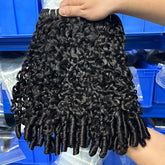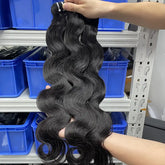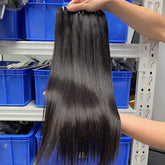Wig Length Chart: Find Your Perfect Hair Length
choosing the right wig length is critical for customer satisfaction and business success in the human hair and wigs market. A wig length chart is an indispensable tool that helps B2B buyers—whether retailers, distributors, or salon owners—visualize and select the perfect hair length for their clientele. In this blog, step-by-step guide, I’ll walk you through how to use a wig length chart effectively, offering practical tips and real-world examples tailored for business professionals. Let’s dive in!
Step 1: Understand Wig Length Measurements
What is a Wig Length Chart?
A wig length chart is a standardized guide that measures wig lengths in inches and shows where the hair falls on the body (e.g., chin, shoulders, or waist). It’s your roadmap to ensuring customers get the look they want.
How Are Wig Lengths Measured?
Wig lengths are measured from the crown of the head to the tips of the hair when laid flat. For straight wigs, this matches the worn appearance, but for curly or wavy wigs, the styled length appears shorter due to texture.
Common Wig Lengths (Straight Wigs)
8 inches: Chin length
10 inches: Jawline to collarbone
12 inches: Shoulder length
14 inches: Just below the shoulders
16 inches: Mid-back
18 inches: Below the shoulder blades
20 inches: Waist length
22 inches: Below the waist
24-30 inches: Hip length
Practical Tip: For curly wigs, add 2-4 inches to the measured length to achieve the desired styled look. Always confirm with suppliers how lengths are listed to avoid surprises.
Step 2: Identify Your Customer Preferences
Know Your Market
Customer preferences vary by region and demographic. Urban buyers might lean toward short, trendy wigs, while others may prefer longer, elegant styles. Understanding your audience is key to stocking the right lengths.
Analyze Sales Data
Review your sales history to pinpoint top-performing wig lengths and identify any with high return rates. This data helps you align inventory with demand.
Real-World Example: A wig retailer in Chicago discovered that 14-inch wigs sold out consistently, while 22-inch wigs lingered on shelves. Using the wig length chart, they shifted focus to mid-length options, boosting sales by 15%.
Step 3: Stock a Variety of Lengths
Diversify Your Inventory
Use the wig length chart to ensure your stock includes a range of lengths—short, medium, and long—to meet diverse customer needs. This variety broadens your appeal.
Balance Popular and Niche Options
Focus on best-sellers, but don’t overlook niche lengths like ultra-short (8 inches) or extra-long (24+ inches) to attract unique buyers.
Practical Tip: Create a visual inventory checklist based on the wig length chart to confirm you’re covering all key categories.
Step 4: Train Your Team
Educate Your Staff
Equip your sales team or retail partners with the knowledge to use the wig length chart. They should explain how lengths look based on customer height, proportions, and wig texture.
Leverage Visual Aids
Provide images or videos of models wearing different wig lengths. This helps customers visualize options and builds confidence in their choices.
Practical Tip: Develop a quick-reference guide with the wig length chart and key selling points for each length to streamline staff training.
Step 5: Consider Seasonal and Trend Influences
Seasonal Adjustments
Wig length preferences often shift with the seasons. Shorter wigs (e.g., 10-12 inches) may dominate in summer for their lightweight feel, while longer wigs (e.g., 18-20 inches) shine in winter.
Follow Industry Trends
Keep an eye on celebrity styles or fashion shifts. A viral bob cut could spike demand for shorter lengths overnight.
Real-World Example: A distributor noticed a surge in 12-inch wig sales during summer and used the wig length chart to adjust stock, increasing revenue by 10%.
Step 6: Advise Customers Wisely
Factor in Face Shape and Lifestyle
While personal style drives decisions, you can offer guidance:
Longer wigs (16-20 inches): Elongate round faces.
Shorter wigs (8-12 inches): Suit active lifestyles with minimal upkeep.
Focus on Individual Style
Avoid assumptions based on age or stereotypes—let customers’ preferences lead the way.
Practical Tip: Suggest virtual try-on tools to show how wig lengths look, enhancing the decision-making process.
Step 7: Learn from Real-World Examples
Example 1: Retail Success
A Los Angeles retailer used the wig length chart to analyze feedback and found that 12-16-inch wigs had the highest satisfaction rates. They adjusted their marketing to spotlight these lengths, driving a 20% sales increase.
Example 2: Salon Partnership
A distributor trained salon partners to use the wig length chart for personalized recommendations. This improved client retention and boosted average order values by 12%.
Key Takeaway: The wig length chart isn’t just a tool—it’s a strategy for smarter business decisions and happier customers.
Common Mistakes to Avoid
Ignoring Texture: Overlooking how curls shorten perceived length can lead to mismatched expectations.
Skipping Feedback: Not adapting inventory to customer data risks overstock or lost sales.
Undertraining Staff: Uninformed teams can’t maximize the chart’s potential, hurting service quality.
Conclusion
Mastering the wig length chart empowers B2B buyers in the human hair and wigs market to stock smarter, advise better, and grow stronger. By following these seven steps, you’ll find the perfect hair length for your customers, enhancing satisfaction and driving sales. Start using this guide today to elevate your business in this competitive industry!







